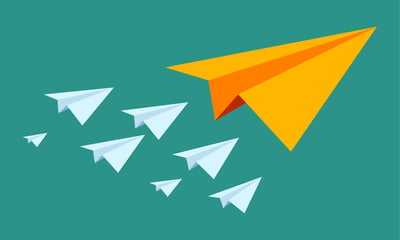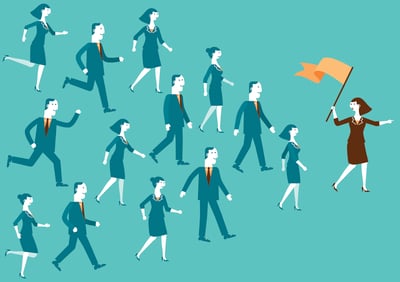April 26, 2019
 by Mary Clare Novak / April 26, 2019
by Mary Clare Novak / April 26, 2019

It is hard to stand behind something you don’t believe in.
You wouldn’t advocate for a meat and poultry processor as a vegetarian, right? Right. It just doesn’t add up.
The same goes for our employers. Working for a company implies that you stand for their big picture mission, vision, and values, as well as their small-scale goals and objectives. Sure, they pay you well and offer decent benefits, but you are providing them with just as much value: your time, energy, and hard work. Wouldn’t you prefer your value be added to an organization where you understand their overall purpose?
It is the job of internal communication to show people within the organization the purpose and value of the company. These actions are referred to as internal marketing.
Marketing is its own communication art form. The goal of marketing messages is to show an audience the value that a business has to offer. Before attempting to do this with external publics, however, the people within the company must first be convinced.
Internal marketing is promoting the mission, objectives, and offerings of a business to people within it. Successful internal marketing can lead to greater employee engagement, brand advocacy, and a motivated workforce, which eventually results in positive interactions with external audiences.
Convincing both internal and external audiences that a company provides value is of equal importance. However, ensuring your workplace understands the worth of a company’s offerings must happen before targeting external groups. If people within a business don’t endorse the product or service they offer, you can’t expect that of outside groups.
Internal marketing should be a priority for any and all types of businesses. Whether you offer a unique product or an unmatched service, getting your employees excited about representing your brand is the first step in grasping the interest of external audiences. However, there are other reasons why internal marketing is a must.
There is nothing more unproductive than a poorly informed workforce. Internal marketing not only answers the “why” questions that people within an organization might have, but also keeps them up to speed on product or service updates. Whether or not your employees directly interact with customers, their knowledge of the brand’s value should be a top priority.
Below is an invitation to a meeting that will give the entire team at G2 an update on new products from that week. This is perfect example of using internal marketing to ensure every team has knowledge of what the business is offering.

Internal communications software can keep your employees informed and help them grow into loyal advocates for your business. Once they understand the value your business offers, they can effectively relay that information to external audiences, on and off the clock.
| Related: Read up on workplace messaging and why it's so important to the modern office. |
Consumers rely on people within a business to provide them with the information, service, and quick fixes they need to harvest benefit. Employees, especially those interacting with customers, must be given the resources they need to provide a pleasant customer experience. Significantly positive and negative encounters with employees stick out to consumers and can shape their perspective of a certain brand.
Not all employees of a company start their career with a background in marketing. However, marketing should be everybody’s responsibility. Every action within a business should be done with marketing goals in mind.
Product developers might ask themselves how they can design the most beneficial product for the consumer. Salespeople could consider how to present those benefits to an individual. Similarly, marketers might wonder what the best method is for showing those benefits to a larger audience.
When marketing messages are understood and incorporated into the work of all teams, it adds a bonus pancake to the consumer benefit short stack.
A business is more efficient when everyone within it is on the same page. When employees understand and support the mission, vision, and values of your business, they will be more engaged and motivated to work hard to reach company goals. If you are a greedy business with no morals, you might be out of luck in this department. Be a place where people are proud to work.
Effective internal marketing doesn't happen on its own. Creating a strategic action plan is a good first step towards success.
The purpose of an internal marketing strategy is to craft messages that will stick with your employees and motivate them to work hard to meet business goals. Similar to an internal communication plan, breaking down the process into different steps will keep you organized along the way and help you pick out areas that need to be improved.
Let’s get started.
Any action plan must begin with goal setting. They provide an overarching idea of why action is being taken and what the final product should look like.
It is crucial that the internal marketing goals align with the goals of the business. After all, the purpose of internal marketing is to provide employees information and motivation to work towards the goals of the company. A solid goal setting guideline is to make sure they are SMART:

An example of an internal communication goal would be for employees to have a deep understanding of company mission, vision, and goals within their first month of employment.
After your goals are set, strategies and tactics must be selected to plan how you will reach those goals. Make sure the strategies and tactics are reasonable given the time and resources of your team. Let’s refer back to the goal mentioned above. A strategy for that goal would be to make mentioning the mission, vision, and values a common occurrence in the workplace. A tactic for that strategy would be to start each team meeting with a quick recap of what the mission, vision, and values are.
Once you have that tactic picked out, put it to action. Keeping the internal marketing goals and strategies in mind, craft your message and consider the best method for reaching your audience. Picking the right communication channel to send your message is just as important as the message itself.
Once the messages have been sent and received, gauge your results. Refer back to the goals you set all the way back in step one and see if they were met or not.
Measuring results can be tricky. Confronting every single employee and asking them to recite the company mission, vision, and values might work, but it isn’t the best method of getting feedback. While you want to judge how well they know the information, a good internal-marketing-result-measurer will also seek how well the audience feels the information was shared with them. Was the message easy to understand, or should it be reworded? Was the appropriate channel used, or would a different one be more effective?
When measuring an internal marketing message, understanding the efficiency of your delivery is just as important as gauging how well the audience absorbed the information.
Take a good look at your results and modify the plan. Did your strategy not work as well as you hoped? Fix it. Did you surpass your goal without any problems? Think bigger. Whether you reached your goal or not, there is always room for improvement. If you really want to make sure your internal marketing plan is as effective as possible, be a stickler. Nitpick every flaw, no matter how small.
Making sure your employees understand both the big picture purpose and the small-scale goals of your business should be a top priority. Not only can they then work towards contributing, but they can also show customers the value of your business. Internal marketing can get you there.
There are a lot of different ways to communicate in the workplace, but no matter which one you use, use these etiquette tips to be heard -- without being offensive.
Want more about communicating with multiple audiences? Check out our resource on internal and external communication!
Mary Clare Novak is a former Content Marketing Specialist at G2 based in Burlington, Vermont, where she is explored topics related to sales and customer relationship management. In her free time, you can find her doing a crossword puzzle, listening to cover bands, or eating fish tacos. (she/her/hers)
The business world never stops changing.
 by Mary Clare Novak
by Mary Clare Novak
There is a time and place for spontaneity, but not when it comes to building an internal...
 by Mary Clare Novak
by Mary Clare Novak
Quick. Think of a famous leader from history. Got one?
 by Mary Clare Novak
by Mary Clare Novak
The business world never stops changing.
 by Mary Clare Novak
by Mary Clare Novak
There is a time and place for spontaneity, but not when it comes to building an internal...
 by Mary Clare Novak
by Mary Clare Novak


